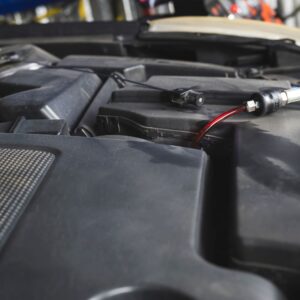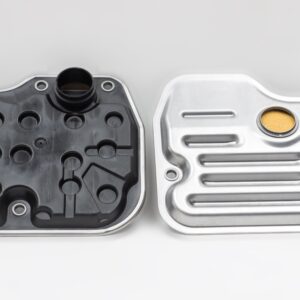Every responsible car owner knows you should never, ever try driving your vehicle without transmission fluid. However, not many truly understand why. To put it simply, driving without transmission fluid is a recipe for disaster.
What Happens if You Run Out of Transmission Fluid?
A number of things can happen when your vehicle runs out of transmission fluid, with none of them being particularly good.
Vehicles With an Automatic Transmission
If you’re driving an automatic vehicle, you’re likely to find yourself stranded until you refill the system with new transmission fluid. Automatic transmission fluid helps the engine and transmission operate together. Without it, the gears won’t spin, and your vehicle can’t move.
Vehicles With a Manual Transmission
Even with insufficient transmission fluid, you can still start and drive your manual vehicle for a few miles. Of course, this doesn’t mean you should. Every mile you force your transmission to endure without transmission fluid is likely to lead to some costly repairs.
Symptoms of Low Transmission Fluid
Even if you can drive your manual vehicle without transmission fluid, it still isn’t a good idea. Doing so can damage your transmission and make it difficult for you to drive. Here are some signs that you’re out of manual transmission fluid (MTF) or running low:
Grinding Noise
Have you noticed any strange sounds coming from your transmission lately? A loud clunking or grinding noise whenever you shift gears typically means you’re low on transmission fluid. You’ll hear this almost immediately. It’ll make so much noise you can’t miss the sound.
Overheating Transmission
Driving on low transmission fluid can cause your transmission to overheat. If the gears don’t lock up from the lack of lubrication, it’ll overheat fast. Because transmission fluid helps cool down your gearbox, not having enough will cause various parts of your transmission to grind against each other. This friction can corrode your transmission and cause gunk to build up.
If the gears do not lock up due to lack of lubrication, it will overheat fast.
–Anthony Harlin, ASE Certified Master Automobile Technician
Delayed Gear Engagement
For automatic vehicles, low transmission fluid means there’s less pressure applied to your gears when shifting. In other words, you’re more likely to experience a delay when shifting gears if you’re driving without transmission fluid.
Gear Slipping
Low transmission fluid can cause your gears to slip, which can make it hard to drive and shift gears.
Transmission Failure
Lastly, driving around with little to no transmission fluid can cause complete transmission failure, which means you’ll probably have to pay a pricey repair bill at the mechanic. If the transmission seizes up, this can also stop the engine from turning over as well.

How Far Can I Drive on Low Transmission Fluid?
If you’re driving an automatic vehicle, then the answer is not very far or at all. Most automatic vehicles have safety features that prevent you from driving once you run out of transmission fluid, so you likely won’t be able to get very far with low transmission fluid.
As for manual vehicles, you can expect to drive around 10 to 15 miles, but keep in mind that many factors can change this. The condition of your vehicle and transmission system can certainly lower those numbers.
What Does Transmission Fluid Do?
In automatic and manual transmissions, transmission fluid lubricates the gearbox’s bearings and metal parts to keep them from grinding against each other and overheating.
Automatic transmission fluid also provides hydraulic pressure and friction, which help various components of the gearbox function. In other words, transmission fluid does the same as engine oil: it lubricates, cleans, and cools the component.
How Do You Add Transmission Fluid?
Adding transmission fluid to your car is a relatively simple process you can do on your own. First, you’ll have to start your car and warm up your transmission fluid for around 30 minutes. Locate your transmission fluid reservoir, remove the dipstick, and use a funnel to carefully refill the tank.
However, most modern vehicles don’t have dipsticks anymore. This means filling the transmission requires you to lift the vehicle and take the plug out while it’s running. When the transmission is at a specific temp, you have to remove another plug to fill.
You can find more information about this in your owner’s manual. The first step is to look up the procedure specific to your vehicle. Some vehicles like Hondas require the vehicle to not be running, while some Chrysler models have to be in neutral. These are very important to know before filling.
How Much Transmission Fluid Should You Put In?
Different vehicles need different amounts of transmission fluid. In general, however, the dipstick should tell you how much you need. If your fluid levels are a little low according to the dipstick, then start with half a quart to a quart of transmission fluid. If you’re replacing all the transmission fluid, you’ll likely need around 9 to 13 quarts of fluid.
Does Low Transmission Fluid Cause Jerking?
Low transmission fluid can cause your vehicle to jerk when accelerating from a standstill, especially after you start your car. However, keep in mind that several other issues can cause jerking, such as a malfunctioning transmission control unit (TCU), brake issues, and a blocked fuel line.
Does Changing Transmission Fluid Improve Performance?
Yes, changing your transmission fluid can improve your vehicle’s overall performance. Replacing old transmission fluid reduces wear on your gearbox while ensuring smoother gear changes. This also means there’s less strain on your engine, which can improve fuel efficiency.
Any information provided on this Website is for informational purposes only and is not intended to replace consultation with a professional mechanic. The accuracy and timeliness of the information may change from the time of publication.






























